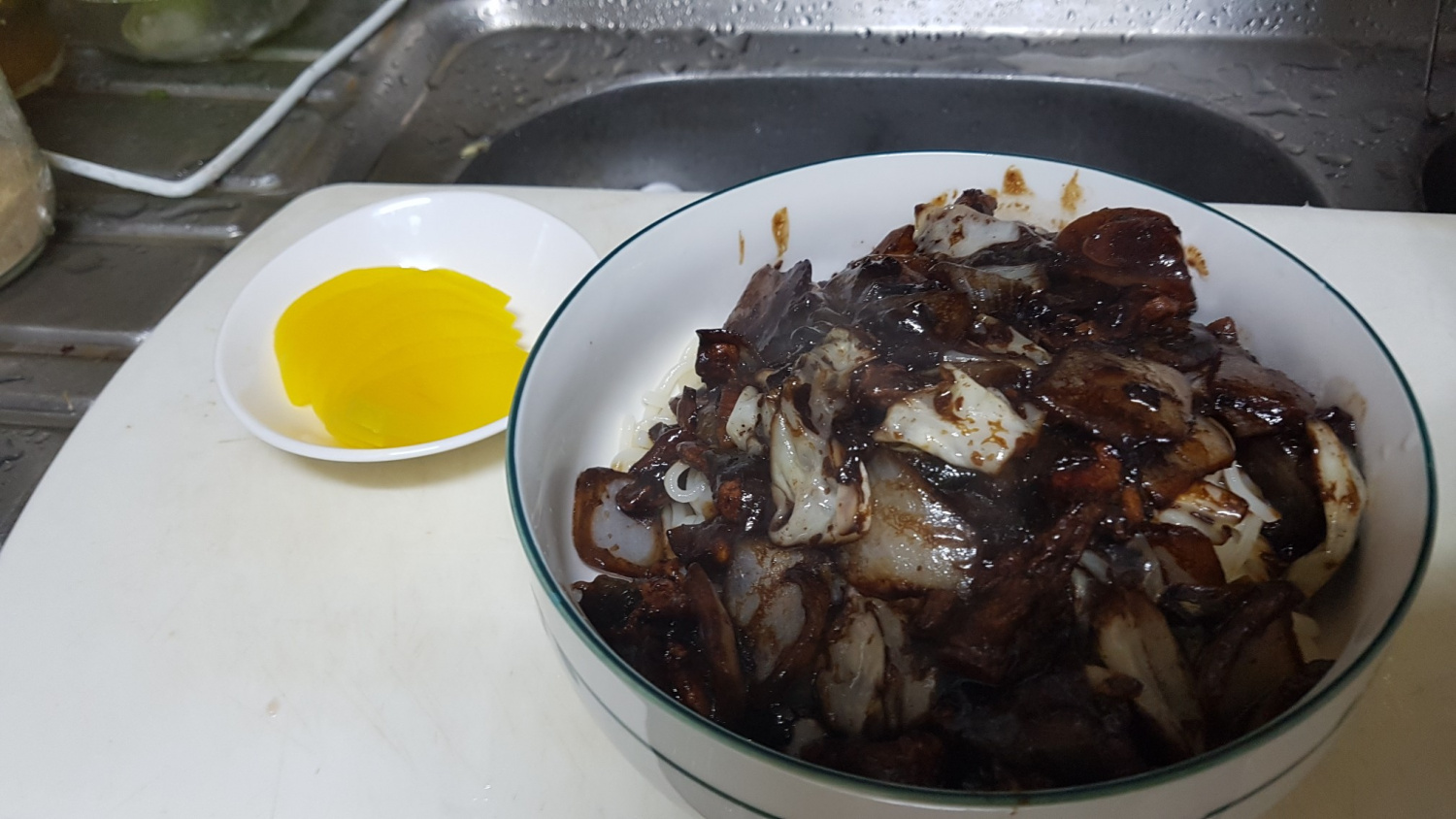Homemade Jjajangmyeon (Korean Black Bean Noodles)
Easy Homemade Jjajangmyeon Recipe

Craving Jjajangmyeon after seeing the famous episode from the Korean show ‘Infinite Challenge’ set on Marado Island? Ordering delivery can sometimes mean a lot of oil. This recipe is for you! Make a healthier and equally delicious version at home. We’ll guide you through perfectly frying the black bean paste and preparing all the ingredients for a truly satisfying meal. Perfect for a cozy day in!
Main Ingredients- 1 serving of fresh Chinese noodles (Jjajangmyeon noodles)
- 1 onion (medium-sized)
- A handful of cabbage (about 1 cup chopped)
- 150g pork (tenderloin, loin, or belly)
- 1 clove garlic (minced)
- 1/2 stalk green onion (finely chopped)
Seasoning Sauce- 1 Tbsp soy sauce
- 1 Tbsp sugar
- 1 Tbsp oyster sauce
- 2 Tbsp Chunjang (Korean black bean paste)
- 2 pinches MSG or flavor enhancer (optional)
- 1 Tbsp soy sauce
- 1 Tbsp sugar
- 1 Tbsp oyster sauce
- 2 Tbsp Chunjang (Korean black bean paste)
- 2 pinches MSG or flavor enhancer (optional)
Cooking Instructions
Step 1
The key to a delicious Jjajangmyeon sauce is properly frying the Chunjang (black bean paste). Heat a generous amount of oil in a pan over low heat and fry the Chunjang, stirring constantly. This process removes any raw, bitter taste and develops a rich, nutty flavor. Skipping this step will result in a bland or sour sauce, so it’s crucial for authentic taste.

Step 2
As you fry the Chunjang, you’ll notice its texture change significantly; it will become smoother and glossier. This indicates it’s perfectly fried. Be careful not to overcook it, as it can become hard and difficult to break down later, potentially adding a burnt taste. Once fried, set the Chunjang aside.

Step 3
Prepare your vegetables. Dice the onion and cabbage into approximately 1.5cm (about 0.6 inches) cubes for a good bite in the sauce. Finely mince the garlic and chop the green onion.

Step 4
Dice the pork into similar 1.5cm (about 0.6 inches) cubes. Pork tenderloin or loin are good choices for a tender texture, but pork belly will add extra richness and flavor. Any cut of pork will work well.

Step 5
Heat a pan with a moderate amount of oil over medium-high heat. Add the diced pork and stir-fry until it’s browned on all sides.

Step 6
Once the pork is mostly cooked, add the minced garlic. Stir-fry together for about 30 seconds until fragrant. The garlic helps to eliminate any porky odor and adds a wonderful aroma to the meat.

Step 7
Lower the heat slightly and add the chopped green onions. Stir-fry until they become fragrant. Then, pour 1 Tbsp of soy sauce around the edges of the pan and let it sizzle and caramelize briefly. This technique, called ‘Bao Guo’ (炒锅), deepens the soy sauce flavor.

Step 8
Add the diced onion and cabbage to the pan. Increase the heat to high and stir-fry quickly until the vegetables are slightly tender but still retain some crunch. Stir-frying over high heat prevents them from becoming mushy.

Step 9
Now, let’s season the sauce for maximum flavor. Add 1 Tbsp of sugar and 1 Tbsp of oyster sauce for sweetness and umami. If you’re using MSG or another flavor enhancer, add the optional 2 pinches now. Stir everything together well to coat the vegetables.

Step 10
Add the reserved fried Chunjang (start with about 1 Tbsp) to the pan. Stir and mix everything thoroughly. Taste the sauce and adjust the amount of Chunjang to your preference for a richer flavor and darker color. You can add more if you desire a more intense taste.

Step 11
For a ‘Ganjjajang’ (dry Jjajangmyeon) style, the sauce is made primarily with the natural juices from the vegetables. If the sauce seems too thick or you need more volume, you can add a little water. To thicken the sauce to your desired consistency, mix 1 part cornstarch with 1 part water to create a slurry, then gradually add it to the simmering sauce while stirring.

Step 12
Bring a pot of water to a boil with a pinch of salt. Cook the fresh Jjajangmyeon noodles according to package directions, usually about 3 minutes. Lightly salting the noodle water enhances the overall flavor. Drain the noodles in a colander and briefly rinse them under cold running water to stop the cooking process and prevent sticking.

Step 13
Place the drained noodles in a bowl. Generously ladle the rich, homemade Jjajang sauce over the noodles. Mix well and enjoy your incredibly delicious, home-cooked Jjajangmyeon! It’s a true culinary delight.




